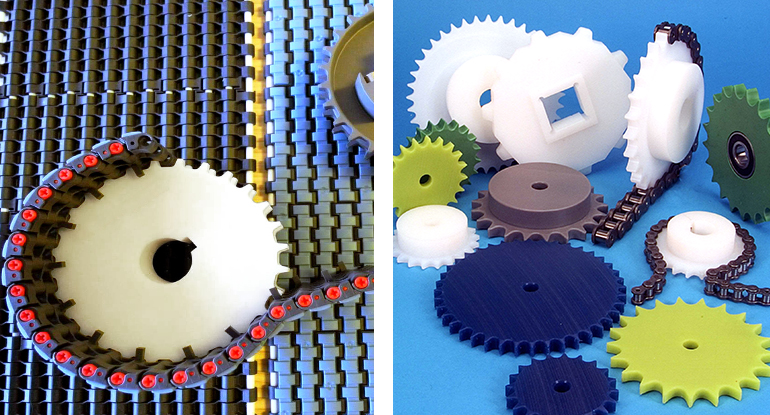Plastic sprockets are a fundamental part of any food conveyor system or food processing machinery. Plastics have long been identified as some of the safest and most efficient materials for use in the food handling industry. Plastic properties such as wear resistance, wide operating temperature ranges, and superior tensile strength offer many benefits. Plastic sprockets are lightweight, durable, and easy to clean, which provides food handling equipment manufacturers with a reliable and versatile component for use in a variety of food preparation and transportation systems.
In applications that require moving parts to come into contact with food, FDA-compliant plastic sprockets and components are outstanding. Their non-porous surfaces won’t harbor bacteria or absorb odors providing superior protection against contamination. Additionally, plastic sprockets and components are easy to sterilize and tolerate disinfectants without breaking down or degrading.
Plastic sprockets are a favorite for food transportation and distribution systems as well. Their characteristic strength and wear-resistance stand up to the constant motion of commercial food preparation, packaging, transportation, and distribution systems. Plastic combines the strength of steel with the lightness of aluminum and will not rot, mildew, or splinter under heavy use.
Types of Plastics Used in the Food Industry
Some of the more popular FDA-approved plastic compounds used in the food industry include:- UHMW (Ultra High Molecular Weight Polyethylene)
Our most popular material, these olefin-based polymers feature excellent chemical resistance with formulations that meet both FDA and USDA standards. UHMW is highly resistant to abrasion and stress-cracking and has great water resistance. For more information on UHMW Properties, see our article Which UHMW Properties Are Best for You? - Acetal Copolymer (Delrin®)
A semi-crystalline compound with extremely low-wear, good rigidity, and durability. It has excellent dimensional stability and low moisture absorption. - PEEK (Polyetheretherketone)
A semi-crystalline material that offers great wear and friction properties, excellent chemical resistance, and exceptionally high-temperature performance of up to 480° F. It’s maintenance-free, wipes clean, and won’t degrade with exposure to water or steam. PEEK offers design versatility with excellent dimensional stability. - Nylon 6
Nylon provides excellent strength and dimensional stability. Nylon has a high rate of water absorption so its use should be limited to dry applications. - PET-P (Polyethylene Terephthalate Polyester)
This semi-crystalline thermoplastic has excellent wear resistance and superior dimensional stability. It is resistant to moderately acidic solutions, capable of sustaining high loads, and has low moisture absorption.
Types of Sprockets
There are many types of chains and belts used on conveyors and packaging machinery that benefit from the properties of plastic sprockets.
- Roller Chain Sprockets
UHMW is an excellent material for roller chain sprockets. The compressibility of UHMW allows for an even distribution of the chain load over multiple teeth. The self-lubricating nature of the material reduces chain wear. These sprockets can have hubs, keyways, and setscrews as required. - Mill Sprockets and Wastewater Applications
UHMW and Nylon Mill sprockets in A-plates, B-hubs, and C-hubs are much lighter than metal sprockets and hold up to impact and tough environments. For instance, the H78 series chain is found in wastewater systems. Wastewater is an excellent application for plastic sprockets because the plastic handles wet, dirty environmental conditions. Additionally, these large sprockets are very heavy if made of metal, so lightweight plastic is often a better option. Bigger parts are frequently made in a split design for ease of installation with large hubs bolted to the plate for strength. - Wire Belt Sprockets
UHMW works great for wire belt sprocket applications on conveyors. The self-lubricating plastic saves wear and tear on the wire belt and helps to dampen noise. Wire belt sprockets will generally have a keyway and two setscrews. - Conveyor Chain Sprockets
Plastic conveyor chains and flat chain sprockets provide lightweight, sound dampening power for conveyor systems. Frequent washdowns with sanitizing chemicals do not harm the specialized plastic materials listed above. One of the concerns of plastic sprockets is if they are strong enough compared to metal sprockets. The large pitch of these chains means the plastic sprockets have plenty of tooth strength and the width provides for a strong keyway.



